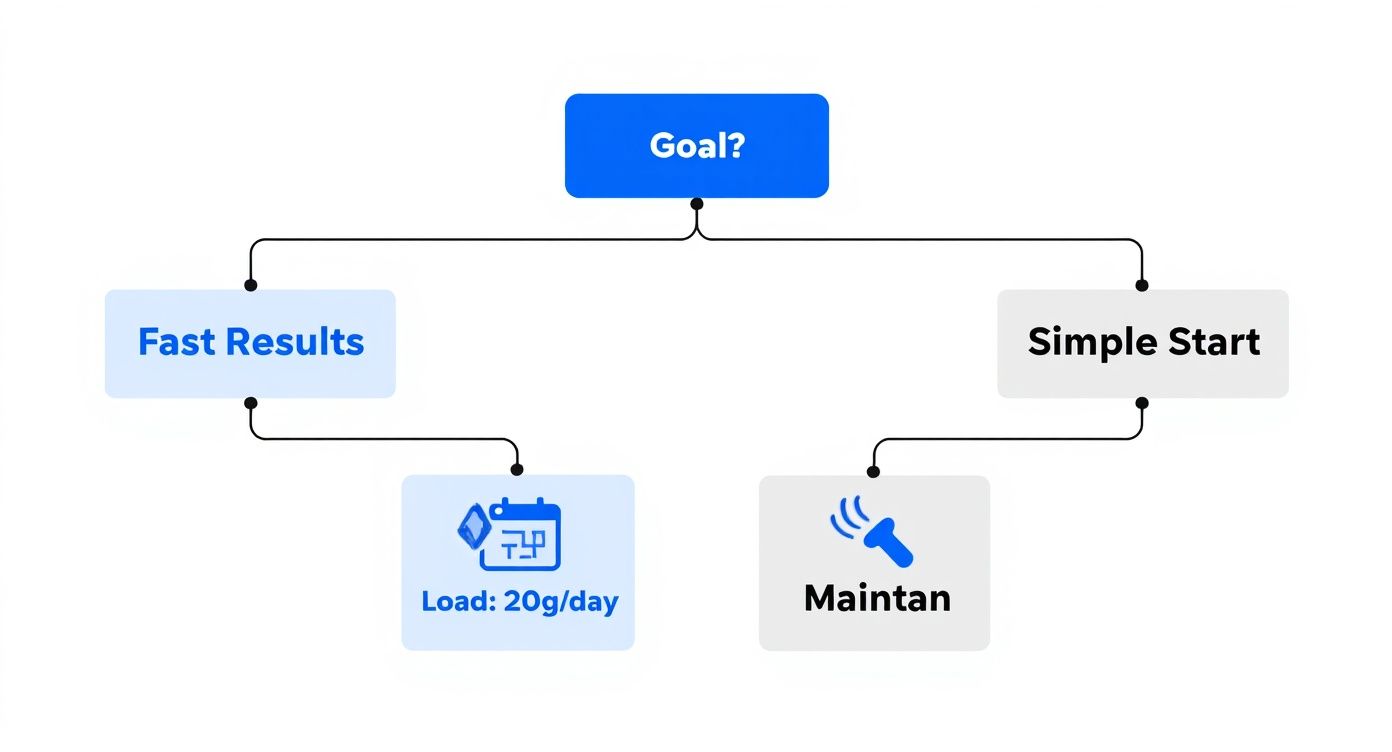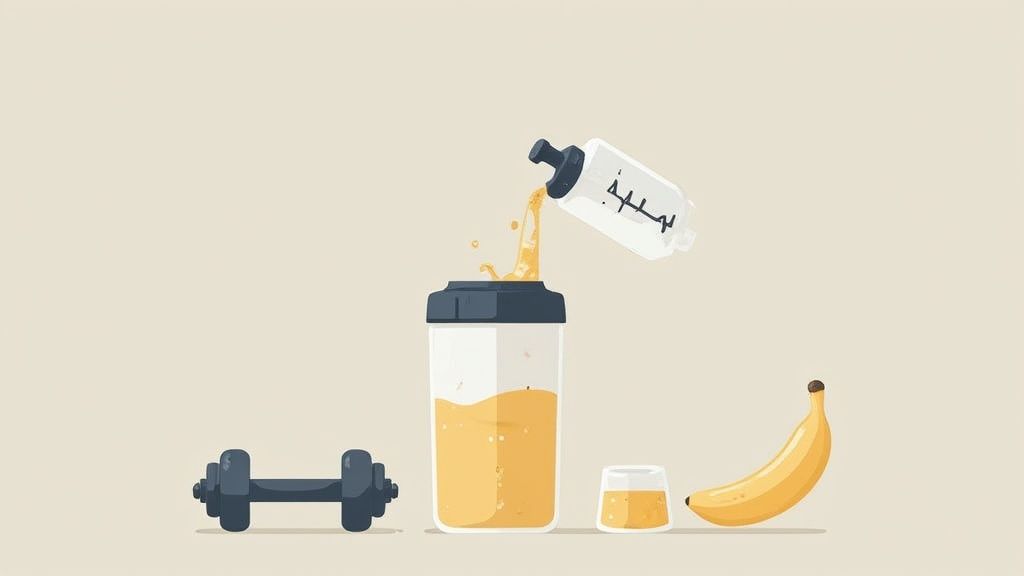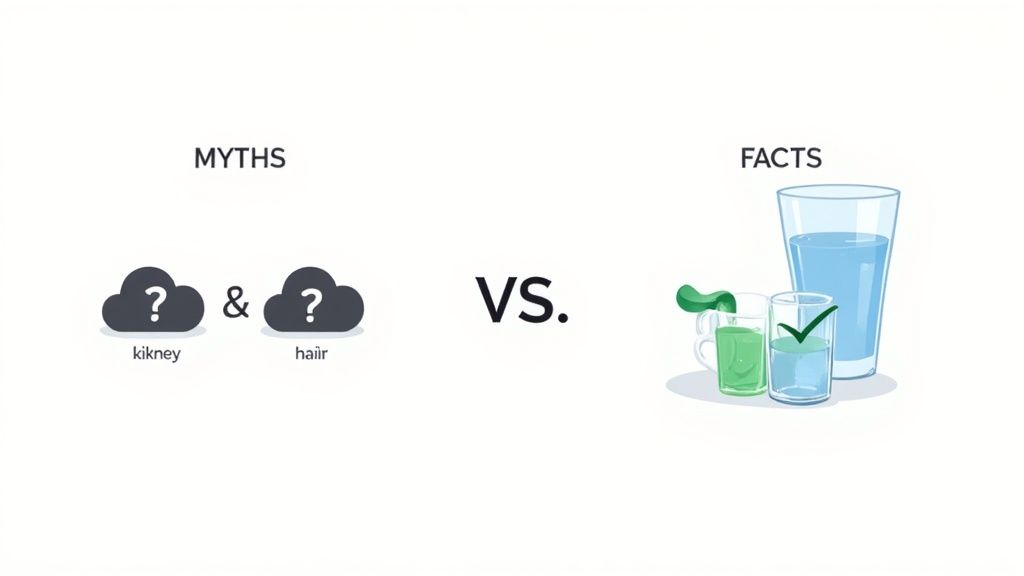How to Take Creatine Effectively: Your Ultimate No-BS Guide to Real Gains
Posted by Maximus
on
Alright, let's cut the crap. You're here because you want to know how to take creatine effectively, not to read a science textbook written by a robot. Forget the confusing advice from the biggest guy at your gym who thinks he's a chemist. We're going to break this down, keep it simple, and get you on the fast track to actual results. This is your definitive, no-nonsense guide.
The entire point of taking creatine is to supercharge your muscles' energy tanks. Think of your muscles like a high-performance engine. Creatine is the high-octane fuel. To get maximum horsepower, you first have to fill the tank, then keep it topped off. There are two dead-simple ways to do this, and honestly, you’d have to try pretty hard to mess it up.
You've got two solid options. One is a rocket ship to Gainsville. The other is a chill, scenic cruise. Both routes lead to the exact same awesome destination: maxed-out muscles ready to demolish your personal records. The only difference is how fast you want to get there.
So, what's it gonna be? The express lane or the scenic route?
Let’s dive into what this actually looks like so you can pick the right gear for your journey to becoming an absolute unit.
This table lays it all out. No secret handshake, no complicated math. Just pick the strategy that vibes with you and get going.
| Strategy | Daily Dose | Duration | Best For |
|---|---|---|---|
| Loading Phase | 20 grams (split into four 5g doses) | 5-7 days | Impatient folks who want to feel the power ASAP. |
| Maintenance Dose | 3-5 grams | Ongoing | Anyone who prefers a simple, steady, no-fuss routine. |
See? Both roads lead to the promised land. The loading phase just gets you there quicker.
The loading method is the one you’ll see in most of the research behind creatine dosing for one reason—it works, and it works fast. Studies consistently show that taking 20 grams of creatine monohydrate daily for 5 to 7 days can jack up your muscle creatine content by a solid 20%.
After that initial high-octane week, you just drop down to a simple 3 to 5 gram daily dose to keep your muscle's "tank" perpetually full.
No matter which path you take, consistency is your superpower. Using a pure, no-frills product like our Three-Atine Creatine Monohydrate makes it stupidly easy because it mixes clean and gets the job done without any extra junk. Just stick with it, and you'll feel that extra gear you've been missing.
So, you've decided to pull the trigger on creatine. Smart move, my friend. Now for the million-dollar question: do you cannonball into the deep end with a "loading phase," or do you just ease in with a steady "maintenance dose"?
Think of it like this: you can take an express train or a scenic route to get to the same killer destination—muscles fully stocked with the fuel they need to go the extra mile.
The loading phase is that express train. It’s for the person who doesn’t just want results, they want them now. This strategy involves taking a higher dose for a short burst to rapidly max out your muscle's creatine stores. It's like flooring the gas pedal to merge onto the highway.
On the other hand, the maintenance dose is the scenic route. It’s a simpler, more laid-back approach where you take a smaller, consistent amount every single day. You'll get to the exact same place, just without the initial rush. This method is often a better fit for folks with sensitive stomachs or anyone who just wants to keep their supplement routine dead simple.
If you're a sprinter at heart and patience isn't your strong suit, the loading phase is your game. The protocol is dead simple: you'll take 20 grams of creatine per day for 5-7 days. The real pro tip to avoid any potential bloating or stomach weirdness is to split that dose up throughout the day.
Don't just slam 20 grams at once. That's a rookie mistake. Instead, try this:
This approach kickstarts the whole process, getting your muscle phosphocreatine levels jacked up in about a week. You’ll likely feel that extra rep in the tank and that little bit of extra power much, much sooner. If you're curious about the timeline, you can learn more about how long creatine takes to work and see exactly why loading gives you that head start.
This decision tree breaks down the two paths you can take based on your goals.

As you can see, both choices lead to fully saturated muscles; it's just a matter of choosing speed versus simplicity.
Not in a mad dash for gains? The maintenance dose is your ticket. This is the absolute definition of "slow and steady wins the race." Instead of that initial 20-gram blitz, you simply start and stay with a daily dose of 3-5 grams.
That's it. One scoop, once a day, every day. No fuss.
The Takeaway: Your muscles will reach full creatine saturation in about three to four weeks with this method, compared to the one week it takes with loading. The end result is identical, so there's really no "wrong" choice here.
This approach is perfect for beginners or anyone who finds the idea of choking down four separate doses a bit much to handle. It’s gentler on your system and incredibly easy to stick with.
Just toss a scoop of a high-quality powder like our Three-Atine Creatine Monohydrate into your daily protein shake or even your morning coffee, and you're golden. At the end of the day, the most important factor for success isn't how you start—it's that you stay consistent.
Alright, you’ve got your dosage figured out. Now, let's get into the nitty-gritty that turns good results into great ones: when you take your creatine and what you mix it with. This is where the real magic happens.
Picture your muscles after a killer workout. They're hungry. They’re depleted. They’re practically screaming for nutrients to start rebuilding. Think of them as sponges, ready to soak up whatever you throw their way. That post-workout window isn't just bro-science; it's your prime opportunity to become a beast.

Slamming your creatine shake right after your final set is an absolute game-changer for absorption. By pairing creatine with the right fuel, you’re basically giving your muscles an express delivery of power and recovery.
This means you can stop just dry-scooping it or mixing it with plain water. Honestly, you're leaving gains on the table if that's all you're doing! To really make it count, you've got to think about what you’re taking it with.
Here’s a pro tip backed by cold, hard science: creatine gets a first-class ticket into your muscles when you take it with carbs, or even better, a mix of carbs and protein. Downing your creatine with a meal or shake that has 50 to 100 grams of carbs can spike muscle creatine retention by a staggering 60% compared to taking it alone. Why? The carbs trigger an insulin response, and insulin acts like a key that unlocks your muscle cells, letting all that good stuff rush in. Don't just take my word for it; you can read the full research about creatine uptake to see the data for yourself.
So, what does this look like in the real world? It's actually simple and delicious. Just make your creatine a part of your post-workout nutrition plan.
Here are a few powerhouse combinations I've used myself:
The bottom line is this: Pairing creatine with simple carbs and protein post-workout drastically improves how much your muscles absorb. It’s the difference between just using creatine and truly mastering it for explosive results.
By making this small tweak to your routine, you ensure every single gram you take is put to work building strength and power, not going to waste. If you’re looking to dive even deeper, check out our guide on the best time to take creatine to really fine-tune your strategy.
https://www.youtube.com/embed/ixkvygVcsuE
We’ve all been there. You and your workout partner start taking creatine on the same day. You’re both fired up, crushing your workouts, and expecting to blow up. Fast forward a month: your buddy looks like he’s been inflated with an air compressor, while you're still squinting in the mirror, searching for a sign.
So, what’s the deal? Did you get a bad batch? Are you secretly doing it wrong?
Relax. It's probably neither. The reality is, creatine isn't a magic potion that works the same for everyone. How your body reacts is intensely personal and comes down to your unique biology. It’s time to stop side-eyeing your buddy's progress and figure out what’s actually going on inside your body.
One of the biggest game-changers is your baseline creatine level—basically, how much creatine is already chilling in your muscles before you even scoop out your first dose. This is almost entirely dictated by your diet.
If you’re a carnivore who eats a lot of red meat and fish, your natural creatine stores are likely already pretty topped off. When you start supplementing, the difference might not feel like a lightning strike. But for vegans and vegetarians? It’s a whole different ball game.
Plant-based diets contain next to no creatine. This means vegetarians and vegans often experience the most explosive and noticeable results from supplementation. Their muscles are like dry sponges, ready to soak up every last gram, which translates to some seriously impressive gains in strength and performance.
This is a massive leg-up for plant-based athletes. It's not that creatine is some secret weapon just for them; it's simply that their starting point is lower, making the jump forward feel that much bigger.
Your own DNA has a massive say in this, especially when it comes to your muscle fiber composition. Some people are just built to respond better.
Your results are heavily tied to things like your muscle fiber type and how long you've been training. People with a higher percentage of type II (fast-twitch) muscle fibers—the explosive ones used for sprinting and heavy lifts—tend to see much bigger strength gains. If you're a natural-born powerlifter, you'll likely get more out of creatine than an elite marathon runner.
And remember, creatine is just one piece of the puzzle. To really maximize your gains, you need a smart training plan and some effective muscle recovery tips to back it up.
If you’re starting to think you're a "non-responder," don't throw in the towel just yet. First, double-check that you're taking it the right way—every day, with plenty of water. Second, understand that true "non-responders" are incredibly rare. It's far more likely you're just a "modest responder." The benefits might be more subtle, like squeezing out one extra rep or feeling a little less sore the next day.
To get the full picture, check out our guide on how creatine works in your body. The most important thing is to stop comparing your chapter one to someone else's chapter ten and focus on your own progress.
Alright, it's time to bust some myths. When it comes to creatine, the gym-floor gossip and "bro-science" can get pretty wild. You've probably heard it all, from dire warnings about your kidneys exploding to your hair making a swift exit. Let's arm you with the actual facts so you can confidently ignore the nonsense.

First things first, this isn't so much a myth as it is the number one mistake people make. Creatine works its magic by pulling extra water into your muscle cells. That’s a good thing! It’s part of what gives you that performance boost and fuller muscles. But, there’s a catch: it means your body's overall demand for water goes way up.
If you don't up your water intake, you're just asking for trouble in the form of dehydration and cramping. Consider it your new golden rule: if you're taking creatine, you're now a hydration fanatic. I'm talking at least a gallon of water a day. Seriously, keep a jug with you everywhere you go. This one simple habit is the difference between creatine being your best friend or your worst enemy.
Let's just put this one to bed for good. No. The whole idea of "cycling" creatine—taking it for a few weeks, then stopping for a while—is a relic from the past. It's a strategy that makes sense for supplements your body can build a tolerance to, like some stimulants in pre-workouts.
But here's the thing: your body does not get used to creatine. Cycling it is actually just shooting yourself in the foot. When you stop, your creatine stores simply dwindle back to normal. Then, when you start up again, you have to go through the whole loading or saturation process all over. Why bother?
The best, most effective way to supplement with creatine is to keep it simple and consistent. Cycling offers zero advantages and just puts the brakes on your progress. Pick a quality powder, take your 3-5 grams every single day, and stop overthinking it.
Now, for the main event—the two rumors that haunt creatine like a ghost. Let's look at what decades of actual research says, not what some guy on a forum claimed happened to his cousin's friend.
1. "Creatine Will Make My Hair Fall Out!"
This one stems from a single, small study way back in 2009. It found that creatine increased levels of a hormone called DHT, which has a link to male pattern baldness. But here's what the fear-mongers leave out: the study never actually measured hair loss, and dozens of bigger, better studies since then have failed to find any connection. For the overwhelming majority of us, there's no credible link between taking creatine and losing your hair.
2. "Creatine Is Going to Wreck My Kidneys!"
This is probably the most stubborn myth of them all. In healthy people, long-term creatine use is one of the most studied things in sports nutrition, and it has never been shown to cause kidney damage. The confusion comes from a little quirk in blood tests. Creatine can slightly elevate a marker called creatinine, which doctors sometimes use to screen for kidney problems. But in this case, it’s a false alarm—just a harmless byproduct of the supplement, not a sign that your organs are in distress.
So, the next time someone tries to hit you with these tired old tales, you can politely set them straight. Just make sure you're using a pure, trusted product, like our top-rated Three-Atine Creatine Monohydrate, to ensure you’re only getting the good stuff.
Alright, we've thrown a lot of science at you. But I know there are probably still a few nagging questions bouncing around in your head. Happens to everyone.
Let's run through a quick-fire Q&A to tackle the most common ones I hear. This way, you can walk away feeling 100% confident you're doing this right.
You've seen them all, right? The fancy tubs with "ethyl-ester," "HCL," or some other space-age name on the label, usually with a price tag to match.
Honestly? Stick with the classic: creatine monohydrate. It’s the most studied, most proven, and most effective form out there. No debate. Don't let clever marketing convince you to spend more on something that doesn't have nearly the mountain of evidence behind it. For nearly everyone, pure monohydrate is the undisputed king.
Ah, the great creatine-caffeine debate. This one comes up a lot. Some old-school studies suggested that caffeine might cancel out creatine's benefits, but that idea is pretty outdated.
Newer research actually points to them being a decent team, since caffeine can help with the uptake of creatine into your muscles. The real problem isn't a chemical one—it's a gut one. Some folks just get an upset stomach when they mix the two. My advice? Try it. If your stomach handles it, you're good to go.
Let’s be direct: yes, the number on the scale will likely go up a few pounds in the first week. But this is not fat. It's water, and it's a good thing.
Creatine works by pulling water into your muscle cells, a process called cellular hydration. This makes your muscles look fuller and more "pumped," not soft and bloated like you might be picturing. That initial water weight is step one. The real gains come later as that extra strength and power in the gym translate into new muscle tissue.
Relax. It's not a big deal. Missing a single dose won't drain your muscles of creatine and kill your progress.
The goal is to keep your creatine stores saturated over the long haul. If you forget today's dose, just hop back on your normal 3-5 gram maintenance dose tomorrow.
Key Takeaway: Consistency over weeks and months is what truly matters, not perfection on any single day. Do not try to "double up" the next day to compensate; it’s unnecessary and might just upset your stomach.
Just get back into the habit. Your muscle stores will stay topped off just fine.
Ready to stop wondering and start seeing results? Grab a tub of Crazy Muscle's pure Three-Atine Creatine Monohydrate. It's the no-nonsense fuel you need to crush your goals.